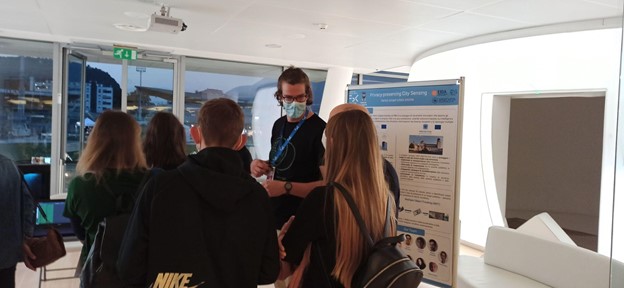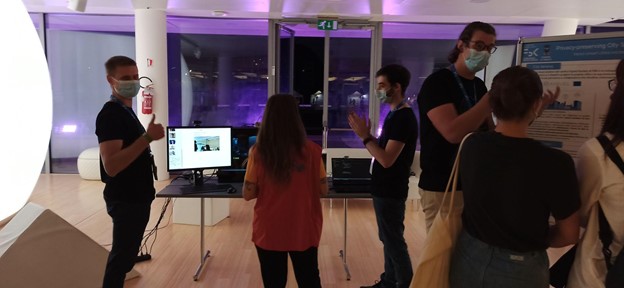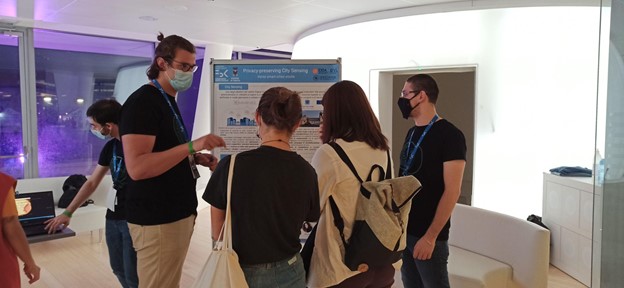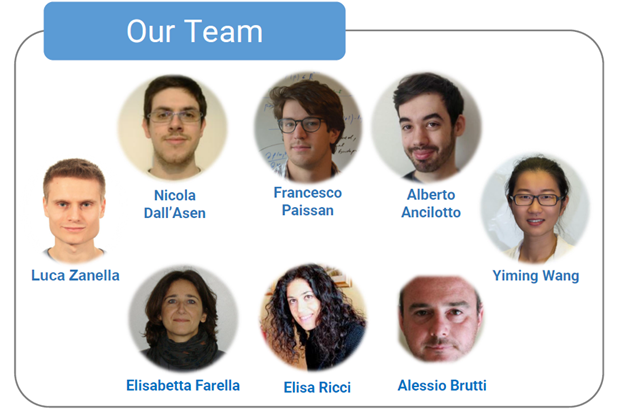European Researchers’ Night: insights from industry and academia

The European Researchers’ Night is a Europe-wide public event, which displays the diversity of science and its impact on citizens’ daily lives in fun and inspiring ways. In Trento, as in 29 other countries, the event took place this year on Friday, 24 September 2021. It was an open event, attended by approximately 2500 people, the majority of which attended face2face and consisted of people from all kinds of backgrounds (students, professors, business and curious citizens).



Like every year since they started, the goal of these nights is to showcase research results to the broader public by making research understandable and possibly reaching young people to raise awareness and curiosity about science and technology and about research careers. Furthermore, the European Researchers’ Night aims to show the impact of researchers’ work on people’s daily lives. This goal is indeed what we wanted to show about the joint work that Fondazione Bruno Kessler and the Municipality of Trento are doing in MARVEL and in another linked project called PROTECTOR. The MARVEL and PROTECTOR projects want to develop innovative tools that help administrators and citizens understand their city and its evolution, using artificial intelligence-based solutions, processing data from multimodal and heterogeneous sources.
After a year of stop due to the COVID-19 pandemic, the European Researchers’ Night in Trento was back this year, and the location chosen was the MUSE, the Science Museum of Trento, in Le Albere district, and in 5 bars in the sourrounding neighborhood. From 2021 the “Researchers’ Night” is also part of the network SHARPER Night – SHAring Researchers’ Passion for Engaging Responsiveness, the largest Italian project for the organization of the “European Researchers’ Night”, which includes 16 cities – including Trento – and is carried out with the collaboration of about 200 universities, research institutions, cultural institutions, businesses, municipalities, regions, and associations of citizens.
What happened that night?
 At the Researcher’s night, FBK team represented by Nicola Dall’Asen, Luca Zanella (both from the DVL research unit) and Francesco Paissan, and Alberto Ancilotto (both from the E3DA research unit) presented four demos to show the impact that the technologies involved in MARVEL have on the community. This was only one out of the 28 initiatives led by FBK and a variety of their departments. The team showcasing the MARVEL related technologies interacted with approximately 400 people and got the chance to perform demos with approximately 150 of them.
At the Researcher’s night, FBK team represented by Nicola Dall’Asen, Luca Zanella (both from the DVL research unit) and Francesco Paissan, and Alberto Ancilotto (both from the E3DA research unit) presented four demos to show the impact that the technologies involved in MARVEL have on the community. This was only one out of the 28 initiatives led by FBK and a variety of their departments. The team showcasing the MARVEL related technologies interacted with approximately 400 people and got the chance to perform demos with approximately 150 of them.
In particular, the team presented a demo about Sound Event Detection trained on the UrbanSound8K dataset, thus detecting urban events like, for example, a dog barking or an engine idling. With a smartphone, we generated events and showed how our algorithms can classify relevant events on very tiny devices (that can also be held in one hand).
The rapid growth of Deep Learning and its usage has fostered growing concerns regarding privacy issues, especially in public spaces. We, therefore, showed a second demo about the anonymization pipeline adopted in MARVEL, which uses generative adversarial networks to transform the participants’ faces into any celebrity of their choice. Traditionally, visual privacy preservation is achieved via video redaction methods. The personal data of a subject is obfuscated. The face is often the most identity-informative part. Classic face anonymization techniques, e.g., blurring or pixelation, can effectively remove PII, but this comes at a high cost of degrading other vision-related tasks, particularly for the action/emotion recognition where the poses play an essential role, e.g., in CCTV footages. Compared to these methods, our pipeline preserves the ability to analyse the images, i.e., preserves pose and expression, while substituting the personal information with those of any other given identity. As we used celebrities’ identities, the effects of anonymization were easily recognizable by the people involved in the demo. Although people found it funny, seeing themselves with different faces, makeup, and facial hair, made them aware that a privacy-preserving application of AI systems is possible.
Multi-Object tracking demo
![]()
![]() Moreover, we presented a demo of Multi-Object tracking running on our custom printed circuit board (PCB) and shown in pictures! In particular, we showed how image-processing techniques can be implemented on tiny devices using novel algorithms achieving very low power consumption. The crowd was also invited to participate in the demo by detecting our faces using the device equipped with a camera and an LCD display.
Moreover, we presented a demo of Multi-Object tracking running on our custom printed circuit board (PCB) and shown in pictures! In particular, we showed how image-processing techniques can be implemented on tiny devices using novel algorithms achieving very low power consumption. The crowd was also invited to participate in the demo by detecting our faces using the device equipped with a camera and an LCD display.
PizzaNet demo
 Finally yet importantly, to introduce the concept of anonymization and how generative adversarial networks work, we trained a couple of cycleGANs to do style transfer on microcontroller units (MCUs). Among the most popular implementations was “PizzaNet”, which anonymizes faces by converting them into pizzas! Can you imagine your face as a pizza? 🙂
Finally yet importantly, to introduce the concept of anonymization and how generative adversarial networks work, we trained a couple of cycleGANs to do style transfer on microcontroller units (MCUs). Among the most popular implementations was “PizzaNet”, which anonymizes faces by converting them into pizzas! Can you imagine your face as a pizza? 🙂
The Researcher’s Night aims at reaching the public at large, bringing science closer to the citizens. What is the best way to involve citizens in science? At a time in history where science is back in the news because of the pandemic, sometimes with unwanted effects such as fake news circulation, what is your opinion of proper science outreach? Is it possible to explain complicated concepts without being misunderstood?
Feel free to reach out using the MARVEL contact form for any comments or questions related to the above. You can also find us on Twitter and LinkedIn.
Signed by: the FBK team
Menu
- Home
- About
- Experimentation
- Knowledge Hub
- ContactResults
- News & Events
- Contact
Funding

This project has received funding from the European Union’s Horizon 2020 Research and Innovation program under grant agreement No 957337. The website reflects only the view of the author(s) and the Commission is not responsible for any use that may be made of the information it contains.

